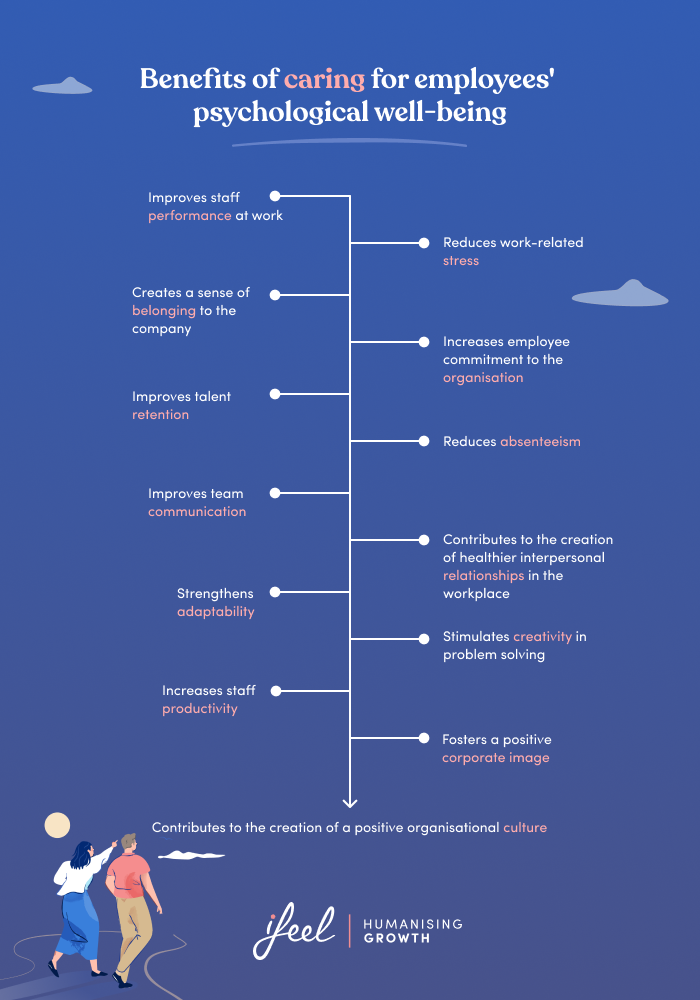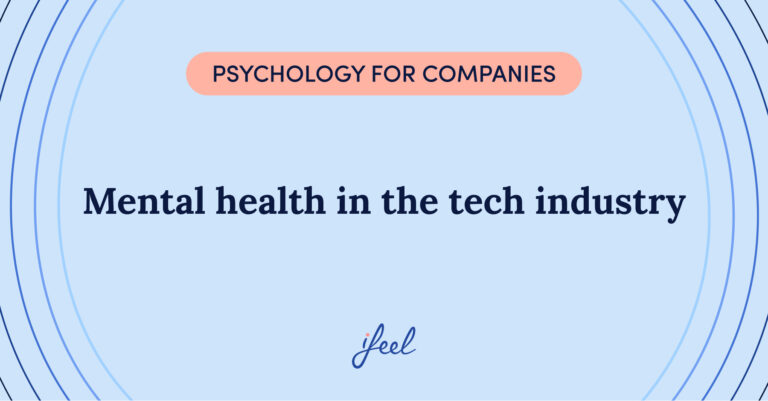A workplace well-being program designed by professionals and implemented by employees is the best tool for caring for the people who make the mission of the organisations they work for possible every day.
Companies that want to make a difference are transforming their vision of the importance of employees’ psychological well-being. Awareness of employee needs is improving employee quality of life and production strategies.
Do you want to increase your company’s performance, are you concerned about the working environment of your employees, or do you need to improve your social benefits strategy? At ifeel, we can provide the right tools through our workplace well-being program to respond to these objectives simply, comfortably, and professionally.
In addition to the economic salary, a valuable way to take care of your employees is to offer them the tools to manage their well-being without leaving home through their computer or cell phone. This way, they will perceive the company as an emotionally safe place.
Companies that value their employees the most strive to improve the emotional rewards they offer them. Supporting employees through life transitions, such as parenthood, is critical to their well-being. Still, companies must go further to make life, and therefore work, easier for them.
Thanks to the evolution of IT and AI tools, more and more organisations can place their employees’ psychological well-being at the heart of their production strategy by implementing a workplace well-being program.
“As a multinational company with professionals in hybrid and full remote format, multicultural, super diverse, with a wide geographical dispersion, and, to top it all off, with professionals who speak different languages, finding you as a partner who could provide us with value wherever our team is and at whatever time, was a great discovery.“
– Virginia Grenón, Head of HR Operation at Cabify, an ifeel partner company
Key resources to boost employees’ and leaders mental well-being
A workplace well-being program must also include several accessible resources, not just for managers but also for employees. To help managers and HR managers foster their employees’ mental health and emotional well-being, it is essential to identify what triggers employees and how these issues can be tackled. Ifeel has created two resources for employees to fill out and take an active role in keeping their well-being at an optimal level.
1. Wellness Action Plan (WAP)
A WAP is a guide for both managers and employees. A WAP can help address work-related mental health issues or act as a preventative tool if issues have not emerged (yet). It is a confidential document that is only filled out by employees and managers.
Ifeel’s WAP includes several questions that employees can fill out to explain their well-being triggers and the actions they think they should take to foster their well-being. Consequently, there is a section for managers where they fill out what actions they believe their employees can take or what the company can do to support the employee. In addition, there are tips to stay healthy at work and definitions the employee can use to describe their feelings.
2. Wellness Action Recovery Plan (WRAP)
Unlike the WAP, the WRAP is a completely confidential document that the employee can share with their manager or HR manager. This tool includes a guide on proactively approaching and addressing well-being issues. It is divided into three core areas:
– Action plan
– Crisis plan
– Post-crisis plan
Each section contains a number of exercises the employee can fill out (with examples if they are unsure how to answer or what to write). It also helps them identify certain signs or situations that warn them that something is wrong.
Why have a workplace health and well-being program?
As stated in a report by Mind Charity, “1 in 6 workers is dealing with a mental health problem such as anxiety, depression, or stress”. This is a worrying statistic as it is likely that people who suffer from mental health problems at work also do outside the workplace. Therefore, supporting these employees in their mental health through a workplace well-being program is crucial, as it will also affect their overall performance. “If you take proactive steps to create a more open and supportive culture, overtime staff should begin to feel more confident to talk to managers about their mental health”.
According to the Mental Health Foundation, “12.7% of all sickness absence days in the UK can be attributed to mental health conditions”. Having a preventative approach is a key factor when tackling mental health issues in the workplace. If organisations can prevent problems from arriving in the first place, they can save a large number of costs which go hand in hand with mental health sick leave.
Providing people with tools to enhance their psychological health in a cross-cutting way, outside and inside the workplace, is unavoidable in implementing a long-term sustainable productivity strategy.

What’s an Employee Assistance Program?
An Employee Assistance Program (EAP) is a workplace well-being program implemented by companies to offer support and tools to their employees who have issues related to their mental health and well-being, which can lead to issues both inside and outside the workplace. The overall objective of giving employees access to an EAP is to enhance individuals’ quality of life by safeguarding their physical and mental health.
These are the benefits of implementing an EAP:
– Improved performance and productivity
– Increased commitment to work
– Reduces absenteeism
– Prevents work fatigue
– Avoids talent flight
HR KPIs
More and more companies implement a workplace well-being program. This shows that employees are either asking for help or it is something HR managers are noticing (whether it is in their feelings or performance). HR KPIs are indicators that HR managers and their teams use to benchmark different elements of work and life in the company. Process improvement is the primary means of improving results. It is best to do this by specifically and explicitly stating our objectives (results) and what indicators will show that we have achieved them. Some key features in HR KPIs include: specificity, making them easy to interpret, diversity, and significance.
HR managers must target their efforts specifically and strategically by establishing Objectives and Key Results (OKRs) that address employees’ mental well-being. Evaluating these objectives can be more effective by setting both qualitative and quantitative goals. This OKR guide can help HR managers facilitate their efforts to improve their employees’ emotional well-being.
Preventing psychosocial risks
The policy of preventing and addressing psychosocial risks at work is becoming increasingly stringent. According to the Ministry of Labor, various psychosocial factors must be considered as job characteristics influencing employees’ psychological well-being. These characteristics would include, for example, the workload and pace of work or the capacity for professional development within the company.
On the other hand, we can also consider other psychosocial aspects that influence the health of the employee and, therefore, the company’s health: relationships between colleagues, leadership style, work methodology, communication management, sense of belonging to the company, and, of course, environmental and ergonomic factors at work.
Without adequate identification and prevention measures, employees may be subjected to varying degrees of risk concerning these psychosocial factors, potentially harming their psychological well-being due to work-related causes.
| Some sources of psychosocial risks in the workplace | ||
| 1. | Task features | Degree of danger or complexity, ability to motivate the worker. |
| 2. | Organisation and methodology | Team coordination, efficiency of processes, leadership of those responsible, quality of internal communication. |
| 3. | Work environment and quality of relationships | Team cohesion, trust and cooperation. |
| 4. | Working conditions | Salary, material resources, time availability, job location, perception of insecurity of physical health. |
Some sources of psychological risks at work
1. Task characteristics: degree of danger or complexity, ability to motivate the worker.
2. Organisation and methodology: team coordination, process efficiency, leadership of those responsible, and quality of internal communication.
3. Work environment and quality of relationships: team cohesion, bonds of trust, and cooperation.
4. Working conditions: salary, material resources, time available, workplace location, perception of insecurity for physical health.
How to prevent psychosocial risks with a workplace well-being program
Ultimately, trying to control psychosocial risks at work consists of taking care of an employee’s perception of themselves as a company member.
To achieve this, it is essential to design an effective strategy to implement decisions on prevention and address the mental health problems that work can generate among employees. This strategy must result from a corporate culture that includes caring for employees’ psychological health among its core values.
Therefore, organisations must take responsibility for preventing the appearance of psychosocial risk factors that may affect their workers by using all available tools.
One of them is to have a workplace well-being program staffed by psychologists who are experts in these issues.
Prevention as a foundation: ifeel’s latest report
The 2023 Mental Well-Being Trends” report by ifeel is an essential resource for understanding and addressing the evolving challenges in mental health within the workplace. As mental health concerns continue to rise globally, staying informed about the latest trends and effective prevention strategies is crucial for any organisation.
This report offers groundbreaking statistics on the current state of mental well-being in companies, the Consultation Roadmap for 2023, and overall user satisfaction levels. Download our report to explore the data we’ve gathered to help organisations like yours put prevention first and create a supportive environment for employees through a workplace well-being program.
Is it compulsory for companies to have a workplace well-being program?
Not exactly, although they must carry out concrete and effective actions aimed at preventing and addressing the effect of the main psychosocial risk factors that can affect employees. Having a workplace well-being program such as the one offered by ifeel is the best way to do this.
What are the main benefits of caring for employees’ psychological well-being?
Employees who enjoy good psychological health are more committed to their company, more motivated with their work, and more involved in the performance of their tasks. They feel that work is not an obstacle to their quality of life. They form cohesive teams and contribute to the organisation’s success.
How does ifeel’s workplace well-being program help companies?
Through different resources (emotional diary, audio, articles, and other exercises), the emotional support service with a psychologist from our team, and, of course, the online therapy service. Personalised, data-driven advice is also offered to HR managers to help them improve their teams’ lives.
Is it essential for employees to undergo psychological therapy?
No, counseling is never a must for employees: the person doing it must need it, be motivated, and be committed to it. However, a complete workplace well-being program offered by companies should facilitate access to psychological therapy with a professional for those employees who want it.

Solutions for large organisations
Taking care of employees’ psychological well-being is a challenge for any company and a necessity, which has been evident since the beginning of the pandemic. Organisations have had to activate rapid and drastic adaptation mechanisms to meet this challenge.
To assist in this process, our team of psychologists specialising in mental well-being has developed a mental well-being program for companies aimed at helping companies enhance employee engagement and boost productivity.
This collaboration allows HR managers to receive personalised, data-based advice on the most effective measures for detecting employee mental health issues and assessing the workplace climate. It’s the best way to understand their needs.
Moreover, ifeel’s corporate mental well-being solution offers employees a structured mental health care service tailored to their needs at any given time.
We hope you found this article on the best workplace well-being program interesting. If you want more information about our mental well-being solution for companies, simply request it, and we will contact your team soon.











